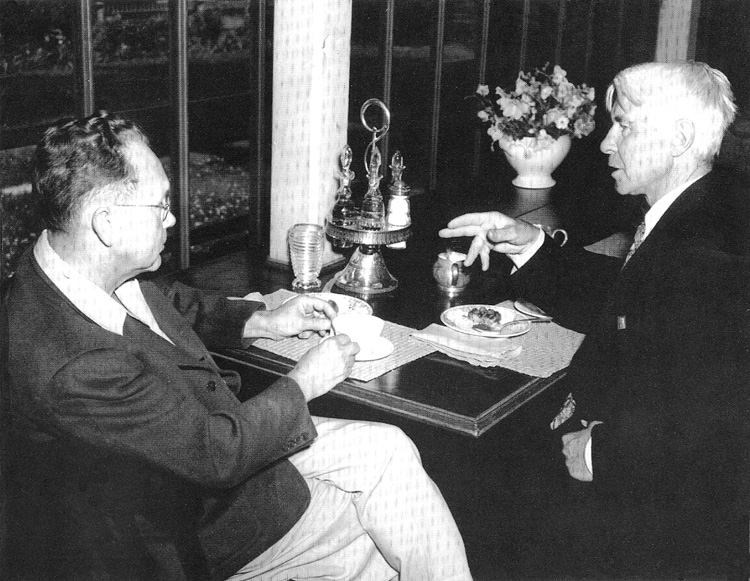|
University
of Iowa art professor Grant Wood (left) shares coffee and conversation with
poet, author and historian Carl Sandburg
By Bob Hibbs
Iowa’s
most famous painter, rural Anamosa native Grand Wood, lived and worked in Iowa
City as a celebrity from 1934 until his death from liver cancer in February
1942 at age 50.
His
most celebrated work – his 1930 “American Gothic,” which some say is not
his best – now resides in the Art Institute of Chicago where Wood was a
student during 1913-1916. He also painted “Stone City” during the same
period. It now hangs in the Joslyn Art Museum in Omaha.
Interestingly,
many of his works are owned by the Cedar Rapids school district where he
taught before coming to Iowa City. A massive mural was painted in the Iowa
State University library in Ames as part of his effort as director of the
depression-era public works of art projects, a federal Civil Works
Administration effort.
During
the 1920s, Wood made four trips to Europe, visiting and studying in Italy,
France and Germany. His most important discoveries seemingly were in Germany,
where in Munich he was impressed by a “new objectivity” movement which
favored orderly realism and rejected abstraction.
Wood
also is said to have admired Flemish and German painters who depicted biblical
scenes using contemporary settings and clothing. Wood developed and advocated
a “regionalism” style, using Iowa scenery and subjects in his work.
Regionalism as a movement essentially died with Wood.
However,
he influenced many students, including several who worked at his early 1930s
art colony located in an old limestone quarry at Stone City located west of
Anamosa. Two nearby quarries still operate today, providing considerable stone
used locally for garden walls and walks.
Among
his most famous Stone City students was the late celebrated Isabelle Bloom
whose commercially-produced garden statuary still sells nationally from her
shops in the Quad Cities. Bloom met her artist husband John Bloom at Wood’s
art colony.
In
Iowa City, Wood lived at 1142 E. Court St., a still-existing 1850s two-story
built by pioneer brickyard owner Nicholas Oakes. The Oakes brickyard was
established by Sylvannus Johnson in 1839 on the southeast corner of the
Burlington-Linn streets intersection now occupied by a five-story building
which for many years served as the local Northwestern Bell Telephone
headquarters.
In
his 1975 “American Classic” book on Iowa City architecture, UI history
Prof. Laurence Lafore describes the Oakes-Wood home in Iowa City as from the
“Basic American House” tradition, a description which seems suited to
Wood’s artistic inclinations.
Wood
came to Iowa City as a celebrity plum for the University of Iowa, but brought
his huge ego with him. The next year – 1935 – Princeton-trained art
historian Lester Longman was recruited to head the UI art department.
Unfortunately, he also was accompanied by a huge ego, setting up a continuing
clash between the men.
Longman
emphasized historical and critical elements in the UI art curriculum, which
Wood saw as coming at the expense of the creative side. Longman viewed
Wood’s style as representing poster art which he thought shouldn’t
dominate the UI program.
Artistic
controversy raged about Wood projecting pictures onto a canvas and painting
over them. Although critics said he was compensating for his own lack of skill
at drawing, he required his students to try the method. Nearly 70 years later,
some art historians now claim “the old masters” used the technique
centuries earlier.
The
battle royal between Longman and Wood even boiled into the state’s
newspapers, including the rumor that a 1940-41 leave taken by Wood represented
his firing.
In
his 1990 UI history, Yale-educated UI history Prof. Stow Persons writes that
“When (Virgil) Hancher became president at the end of 1940, one of his first
tasks was to settle the Wood controversy.”
Persons notes that a year later Wood offered his resignation from his
hospital bed, “which the university in all decency refused to accept.”
Wood’s
talented work survives him.
Next
Saturday:
Nile Kinnick, Iowa’s greatest football player. Bob Hibbs collects local postcards and researches history related to them. |
